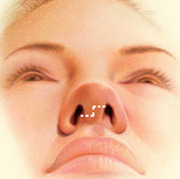Septalplasty > Procedures
The surgical procedure for correction of a nasal problem, or Septalplasty,
that may involve breathing problems, (internal) reconstructive or cosmetic
problems, (external), or a combination of internal and external complaints.
The corrective procedures are called septalplasty and nasalplasty.
If You're Considering Septalplasty
At the time of your first office visit, the Doctor will discuss the
surgical procedure with you. If you have problems such as airway obstruction
you may have a deviated septum. the Doctor will look into your nose
with a very thin scope to determine if this is the case. If you are interested
in a cosmetic change, the Doctor will discuss possible goals of surgery
with you.
Making the Decision
For patients having septal surgery, general anesthesia is usually used,
as most septal deviations are deep in the nose. Most people have intravenous
sedation and local anesthesia. This means you will be given medications
to relax you through an IV and then the Doctor will numb the nasal area.
You should be aware that conditions may occur which may require less
than total correction of symptoms (a limited resection). The Doctor will
use his best judgment at the time of surgery. Rather than resect a greater
amount of tissue and cause possible harm, the Doctor will do a lesser
correction. He will discuss this with you before your surgery.
Preparing for surgery
 Prior
to surgery, you may be asked to: Prior
to surgery, you may be asked to:
 Get lab testing or a medical evaluation Get lab testing or a medical evaluation
 Take certain medications or adjust your current medications Take certain medications or adjust your current medications
 Stop smoking well in advance of surgery Stop smoking well in advance of surgery
 Avoid taking aspirin, anti-inflammatory drugs and herbal supplements as they can increase bleeding Avoid taking aspirin, anti-inflammatory drugs and herbal supplements as they can increase bleeding
Special instructions you receive will cover:
 What to do on the day of surgery What to do on the day of surgery
 The use of anesthesia during your liposuction The use of anesthesia during your liposuction
 Post-operative care and follow-up Post-operative care and follow-up
Your
plastic surgeon will also discuss where your procedure will be
performed. Liposuction may be performed in an accredited office-based
surgical center, outpatient or ambulatory surgical center, or a
hospital. You’ll need helpIf
your liposuction is performed on an outpatient basis, be sure to
arrange for someone to drive you to and from surgery and to stay with
you for at least the first night following surgery. Back to Top
Important facts about the safety and risks of nose surgery
The decision to have nose surgery is extremely personal and you’ll
have to decide if the benefits will fulfill your goals and if the risks
and potential complications are acceptable.
Your
plastic surgeon and/or staff will explain in detail the risks
associated with surgery. You will be asked to sign consent forms to
ensure that you fully understand the procedure you will undergo and any
risks or potential complications. The risks include:
 Rupture of small surface vessels of the nose Rupture of small surface vessels of the nose
 Infection Infection
 Poor wound healing Poor wound healing
 Anesthesia risks Anesthesia risks
 Bleeding (hematoma) Bleeding (hematoma)
 Nose asymmetry Nose asymmetry
 Cardiac
and pulmonary complications can occur in longer surgical procedures and
may be associated with the formation of, or increase in, blood clots in
the venous system Cardiac
and pulmonary complications can occur in longer surgical procedures and
may be associated with the formation of, or increase in, blood clots in
the venous system
 Change in skin sensation (numbness) Change in skin sensation (numbness)
 Nasal
airway alterations may occur after a rhinoplasty or septoplasty that
may interfere with normal passage of air through the nose Nasal
airway alterations may occur after a rhinoplasty or septoplasty that
may interfere with normal passage of air through the nose
 Nasal
septal perforation (a hole in the nasal septum) may develop but is
rare; additional surgical treatment may be necessary to repair the
nasal septum but in some cases, it may be impossible to correct this
complication Nasal
septal perforation (a hole in the nasal septum) may develop but is
rare; additional surgical treatment may be necessary to repair the
nasal septum but in some cases, it may be impossible to correct this
complication
 Pain, which may persist Pain, which may persist
 Unfavorable scarring Unfavorable scarring
 Skin contour irregularities Skin contour irregularities
 Skin discoloration and swelling Skin discoloration and swelling
 Sutures may spontaneously surface through the skin, become visible or produce irritation that require removal Sutures may spontaneously surface through the skin, become visible or produce irritation that require removal
 Possibility of revisional surgery Possibility of revisional surgery
Be sure to ask questions:
It’s very important to ask your plastic surgeon questions about your
nose procedure. It’s natural to feel some anxiety, whether it’s
excitement for your anticipated new look or a bit of preoperative
stress. Don’t be shy about discussing these feelings with your plastic
surgeon. When you go homeIf
you experience shortness of breath, chest pains, or unusual heart
beats, seek medical attention immediately. Should any of these
complications occur, you may require hospitalization and additional
treatment. The
practice of medicine and surgery is not an exact science. Although good
results are expected, there is no guarantee. In some situations, it may
not be possible to achieve optimal results with a single surgical
procedure. Another minor surgery may be necessary to reach the intended
aesthetic goal. Be carefulFollowing
your physician’s instructions is key to the success of your surgery. It
is important that the surgical incisions are not subjected to excessive
force, abrasion, or motion during the time of healing. Your doctor will
give you specific instructions on how to care for yourself.
Procedural Steps:What happens during nose surgery?Step 1 – AnesthesiaMedications
are administered for your comfort during the surgical procedure. The
choices include intravenous sedation or general anesthesia. Your doctor
will recommend the best choice for you. Step 2 – The incisionSurgery
of the nose is performed either using a closed procedure, where
incisions are hidden inside the nose, or an open procedure, where an
incision is made across the columella, the narrow strip of tissue that
separates the nostrils. Through
these incisions, the soft tissues that cover the nose are gently
raised, allowing access to reshape the structure of the nose.  
Step 3 – Reshaping the nose structureSurgery of the nose can reduce or augment nasal structures with the use of cartilage grafted from other areas of your body. Most commonly, pieces of cartilage from the septum, the partition in the middle of the nose, is used for this purpose. Occasionally a piece of cartilage from the ear and rarely a section of rib cartilage can be used. Step 4 – Correcting a deviated septumIf the septum is deviated, it is now straightened and the projections inside the nose are reduced to improve breathing. Step 5 – Closing the incisionOnce
the underlying structure of the nose is sculpted to the desired shape,
nasal skin and tissue is redraped and incisions are closed. Additional
incisions may be placed in the natural creases of the nostrils to alter
their size. Step 6 – See the resultsSplints and internal tubes will likely support the nose as it begins to heal for approximately one week. While initial swelling subsides within a few weeks, it may take up to a year for your new nasal contour to fully refine. During
this time you may notice gradual changes in the appearance of your nose
as it refines to a more permanent outcome. Swelling may come and go and
worsen in the morning during the first year following your nose surgery.  
Nose
surgery to improve an obstructed airway requires careful evaluation of
the nasal structure as it relates to airflow and breathing. Correction
of a deviated septum, one of the most common causes of breathing
impairment, is achieved by adjusting the nasal structure to produce
better alignment. Back to Top
My recovery After
your procedure is completed, a splint, internal tubes or packing will
likely be placed inside your nose and a splint or bandages placed on
the outside to support and protect the new structures during initial
healing. After
your procedure is completed, a splint, internal tubes or packing will
likely be placed inside your nose and a splint or bandages placed on
the outside to support and protect the new structures during initial
healing.
You will be given specific instructions that may include:
How to care for the surgical site, medications to apply or take orally
to aid healing and reduce the potential for infection, specific
concerns to look for at the surgical site or in your general health,
and when to follow up with your plastic surgeon. Be sure to ask your plastic surgeon specific questions about what you can expect during your individual recovery period.
 Where will I be taken after my surgery is complete? Where will I be taken after my surgery is complete?
 What medication will I be given or prescribed after surgery? What medication will I be given or prescribed after surgery?
 Will I have dressings/bandages after surgery? Will I have dressings/bandages after surgery?
When will they be removed?
 Are stitches removed? When? Are stitches removed? When?
 When can I resume normal activity and exercise? When can I resume normal activity and exercise?
 When do I return for follow-up care? When do I return for follow-up care?
Back to Top
The results will be long-lasting
It may take several months for swelling to fully dissipate and up to
a year - and sometimes longer - for the outcome of the surgery to fully
refine.
Although
the results of nose surgery are usually permanent, cartilage may
continue to reshape and move tissue that may change the outcome over
time. Back to Top How much will nose surgery cost?Cost
is always a consideration in elective surgery. Prices for nose
surgeries can vary widely. A surgeon’s cost may vary based on his or
her experience as well as geographic office location. Many plastic surgeons offer patient financing plans, so be sure to ask. Cost may include:
 Surgeon’s fee Surgeon’s fee
 Hospital or surgical facility costs Hospital or surgical facility costs
 Anesthesia fees Anesthesia fees
 Prescriptions for medication Prescriptions for medication
 Medical tests Medical tests
When
nose surgery is performed to improve breathing function, this procedure
is considered reconstructive and may be covered by insurance. This
requires a detailed examination to verify the cause of your breathing
impairment and prior authorization from your insurer.  Your satisfaction involves more than a fee Your satisfaction involves more than a fee
When
choosing a plastic surgeon for nose surgery, remember that the
surgeon’s experience and your comfort with him or her are just as
important as the final cost of the surgery. Back to Top Words to know
 Cartilage: Connective tissue that forms the structure of the nose. Cartilage: Connective tissue that forms the structure of the nose.
 Columella: The narrow strip of tissue that separates the nostrils. Columella: The narrow strip of tissue that separates the nostrils.
 Deviated septum: Cartilage that separates the nostrils is misaligned which may cause partial nasal airway obstruction. Deviated septum: Cartilage that separates the nostrils is misaligned which may cause partial nasal airway obstruction.
 General anesthesia: Drugs and/or gases used during an operation to relieve pain and alter consciousness. General anesthesia: Drugs and/or gases used during an operation to relieve pain and alter consciousness.
 Hematoma: Blood pooling beneath the skin. Hematoma: Blood pooling beneath the skin.
 Intravenous sedation: Sedatives administered by injection into a vein to help you relax. Intravenous sedation: Sedatives administered by injection into a vein to help you relax.
 Local anesthesia: A drug injected directly to the site of an incision during an operation to relieve pain. Local anesthesia: A drug injected directly to the site of an incision during an operation to relieve pain.
 Rhinoplasty: Surgery to reshape the nose. Rhinoplasty: Surgery to reshape the nose.
Back to Top Questions to ask my plastic surgeonUse this checklist as a guide during your consultation
 Are you certified by the American Board of Plastic Surgery? Are you certified by the American Board of Plastic Surgery?
 Are you a member of the American Society of Plastic Surgeons? Are you a member of the American Society of Plastic Surgeons?
 Were you specifically trained in the field of plastic surgery? Were you specifically trained in the field of plastic surgery?
 How many years of plastic surgery training have you had? How many years of plastic surgery training have you had?
 Do you have hospital privileges to perform this procedure? Do you have hospital privileges to perform this procedure?
 If so, at which hospitals? If so, at which hospitals?
 Is
the office-based surgical facility accredited by a nationally- or
state-recognized accrediting agency, or is it state-licensed or
Medicare-certified? Is
the office-based surgical facility accredited by a nationally- or
state-recognized accrediting agency, or is it state-licensed or
Medicare-certified?
 Am I a good candidate for this procedure? Am I a good candidate for this procedure?
 What will be expected of me to get the best results? What will be expected of me to get the best results?
 Where and how will you perform my procedure? Where and how will you perform my procedure?
 What surgical technique is recommended for me? What surgical technique is recommended for me?
 How long of a recovery period can I expect, and what kind of help will I need during my recovery? How long of a recovery period can I expect, and what kind of help will I need during my recovery?
 What are the risks and complications associated with my procedure? What are the risks and complications associated with my procedure?
 How are complications handled? How are complications handled?
 How can I expect my nose to look over time? How can I expect my nose to look over time?
 What are my options if I am dissatisfied with the cosmetic outcome of my nose surgery? What are my options if I am dissatisfied with the cosmetic outcome of my nose surgery?
 Do you have before-and-after photos I can look at for this procedure and what results are reasonable for me? Do you have before-and-after photos I can look at for this procedure and what results are reasonable for me?
Back to Top |





